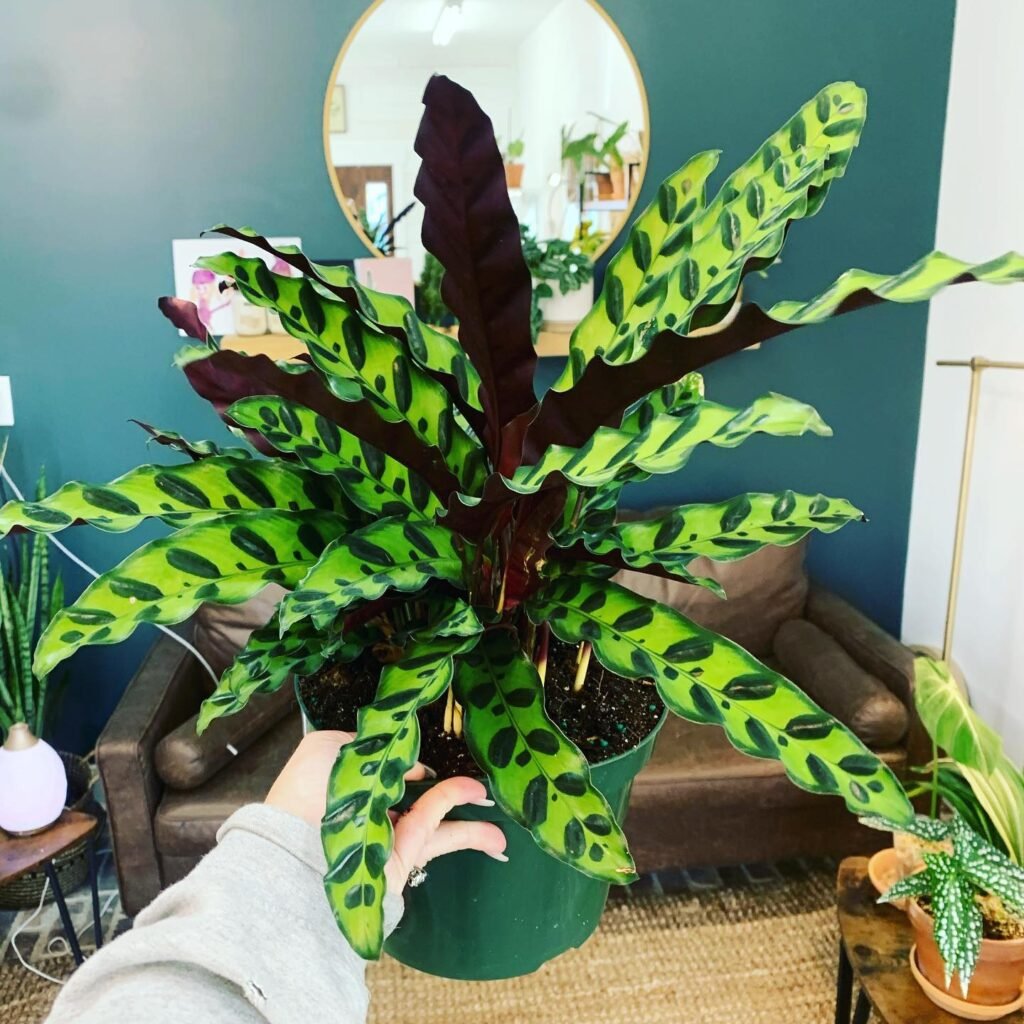Did you know that the Calathea Lancifolia, also known as the Rattlesnake Plant, is becoming increasingly popular as a tropical indoor plant in the UK? Its unique lance-shaped leaves and stunning variegated pattern make it a standout addition to any indoor plant collection.
In this guide, I will share my tips and advice on how to care for your Calathea Lancifolia and ensure it remains a healthy and vibrant presence in your home. From providing the right light conditions to proper watering techniques, I’ve got you covered with all the essential indoor plant care tips you need to know.
Appearance of Calathea Lancifolia (Rattlesnake Plant)
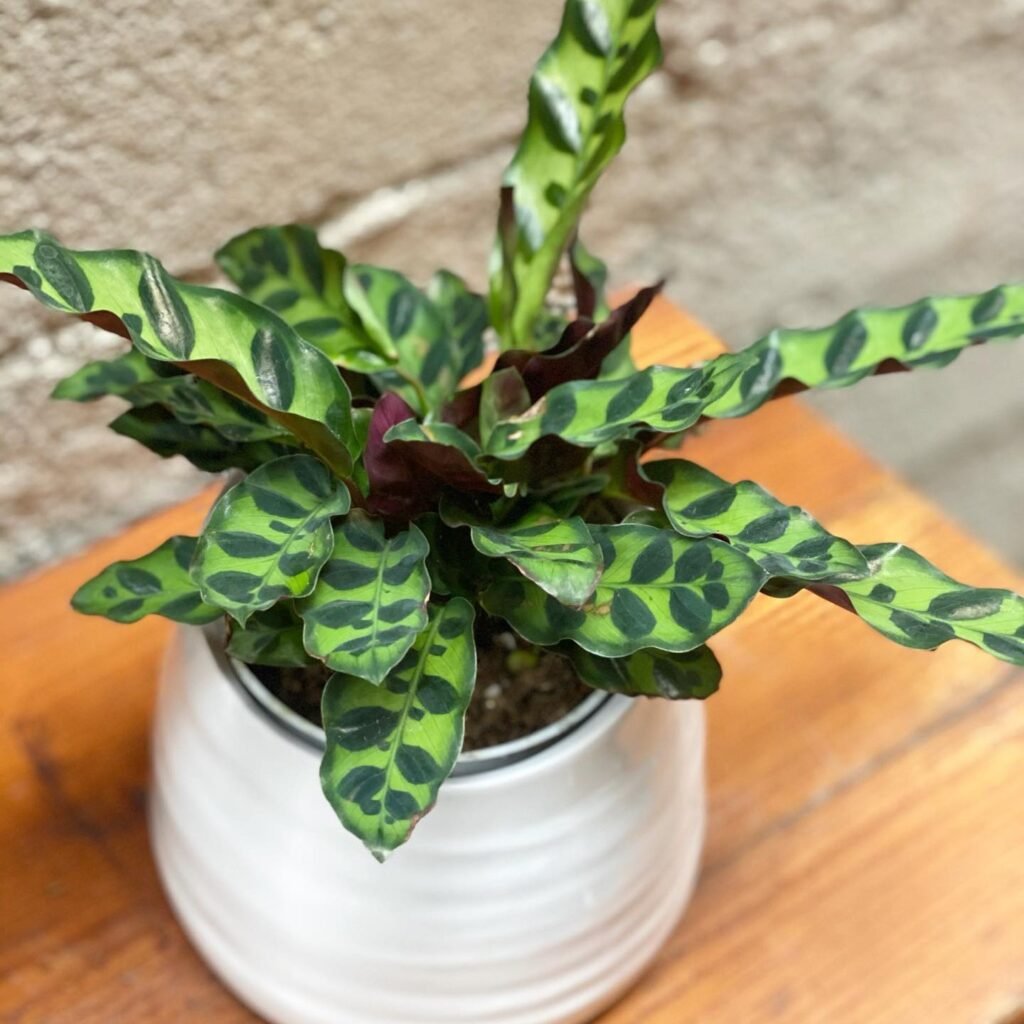

The Calathea Lancifolia, or Rattlesnake Plant, displays striking lance-shaped leaves with a captivating variegated pattern. The leaves feature long, wavy edges and elegant dark green strokes on a pale green background. This unique combination of colors and textures creates a visually appealing contrast.
Adding to its allure, the undersides of the leaves showcase a beautiful burgundy red hue, complementing the vibrant display on the top. The velvety texture of the undersides further accentuates the plant’s aesthetic appeal.
With its distinctive appearance, the Calathea Lancifolia stands out as an eye-catching centerpiece in any indoor space, adding a touch of tropical beauty and elegance.
 The Calathea Lancifolia, or Rattlesnake Plant, exhibits fascinating leaf movements, tracking the sun from dawn to dusk. This behaviour, known as nyctinasty, helps optimise light absorption and deter pests. Its unique leaf dynamics add a mesmerising, lively touch to any room.
The Calathea Lancifolia, or Rattlesnake Plant, exhibits fascinating leaf movements, tracking the sun from dawn to dusk. This behaviour, known as nyctinasty, helps optimise light absorption and deter pests. Its unique leaf dynamics add a mesmerising, lively touch to any room.
Light Requirements for Calathea Lancifolia


Calathea Lancifolia, also known as the Rattlesnake Plant, thrives in indirect light or light shade. It is important to avoid exposing this plant to direct sunlight, as it can cause the leaves to fade and lose their beautiful markings. If you notice the green spots on the leaves fading, it indicates that the plant needs more shade.
To provide the ideal lighting conditions for your Calathea Lancifolia, find a bright spot in a well-lit room, positioned around 3 meters away from the window. This ensures the plant receives a good amount of light without being exposed to the harsh rays of the sun.

Watering Tips for Calathea Lancifolia (Rattlesnake Plant)
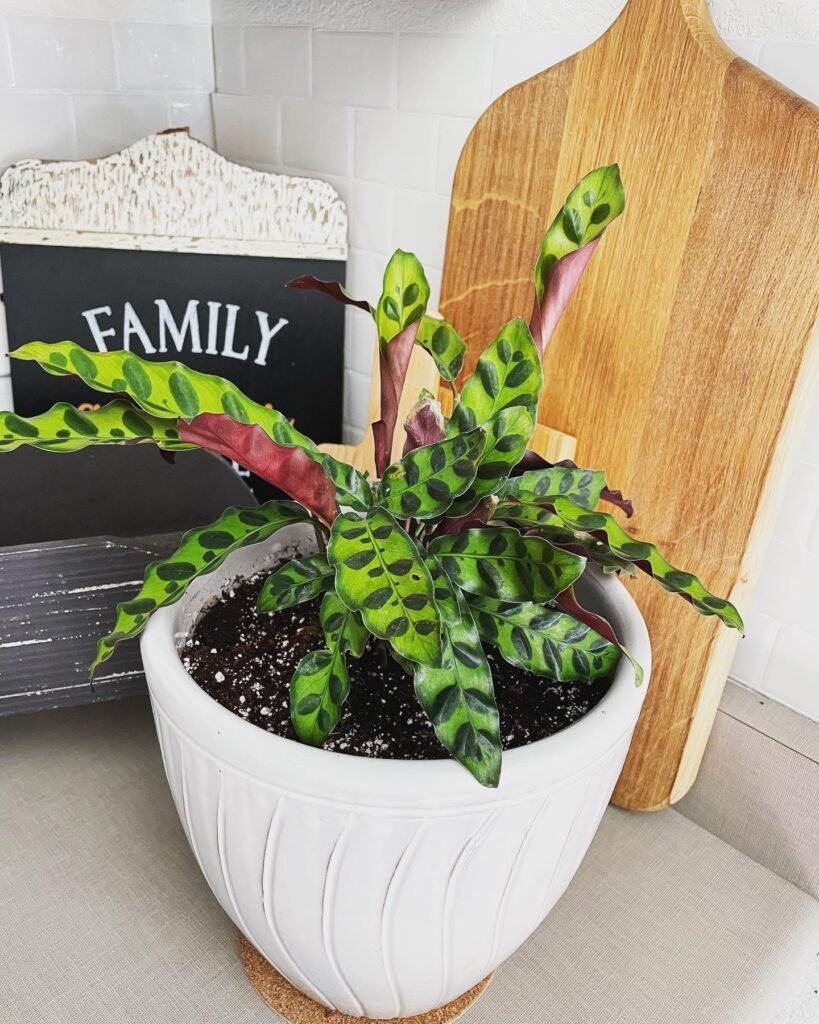
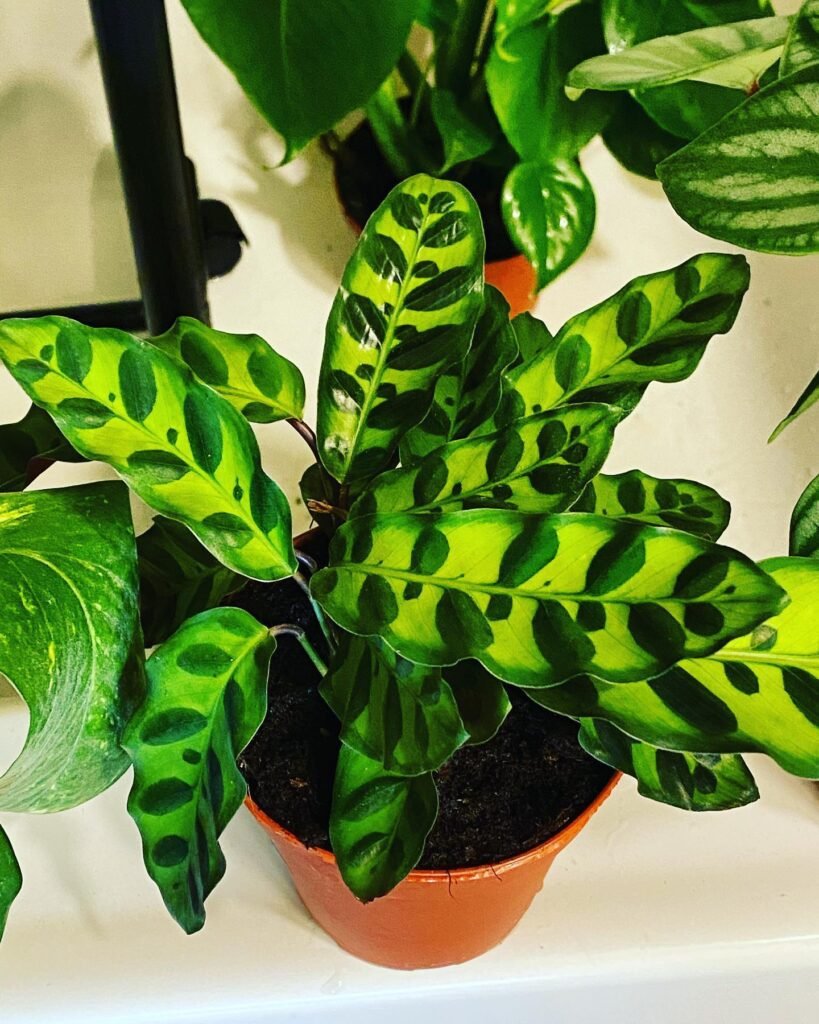
Proper watering is crucial for the health of your Calathea Lancifolia, also known as the Rattlesnake Plant. To maintain optimal growth, it’s important to keep the soil consistently damp. However, be careful not to let the plant sit in water or overly wet soil, as this can lead to root rot.
The best watering strategy for your Calathea Lancifolia is to water it little and often, ensuring that the soil remains moist but not waterlogged. This plant thrives in slightly damp soil conditions, so it’s important not to let the soil dry out completely between waterings. Regularly check the moisture level of the soil by inserting your finger about an inch deep. If it feels dry, it’s time to water.
Top watering tip: When watering your Rattlesnake Plant, ensure that water reaches all parts of the soil and drains out completely. This helps prevent water from pooling, which can lead to root rot.
- Use room temperature water to avoid shocking the plant.
- Water the plant until you see water coming out of the drainage holes, then empty the saucer or tray beneath to prevent waterlogged conditions.
- Consider using filtered or distilled water if your tap water contains high levels of chlorine or minerals that could be harmful to the plant.
It’s important to find the right balance when watering your Calathea Lancifolia. Overwatering can lead to root rot and other issues, while underwatering can cause the leaves to curl up. By following these watering tips and keeping the soil consistently damp, you can help ensure a happy and healthy Rattlesnake Plant.

Fertilizing and Soil for Calathea Lancifolia
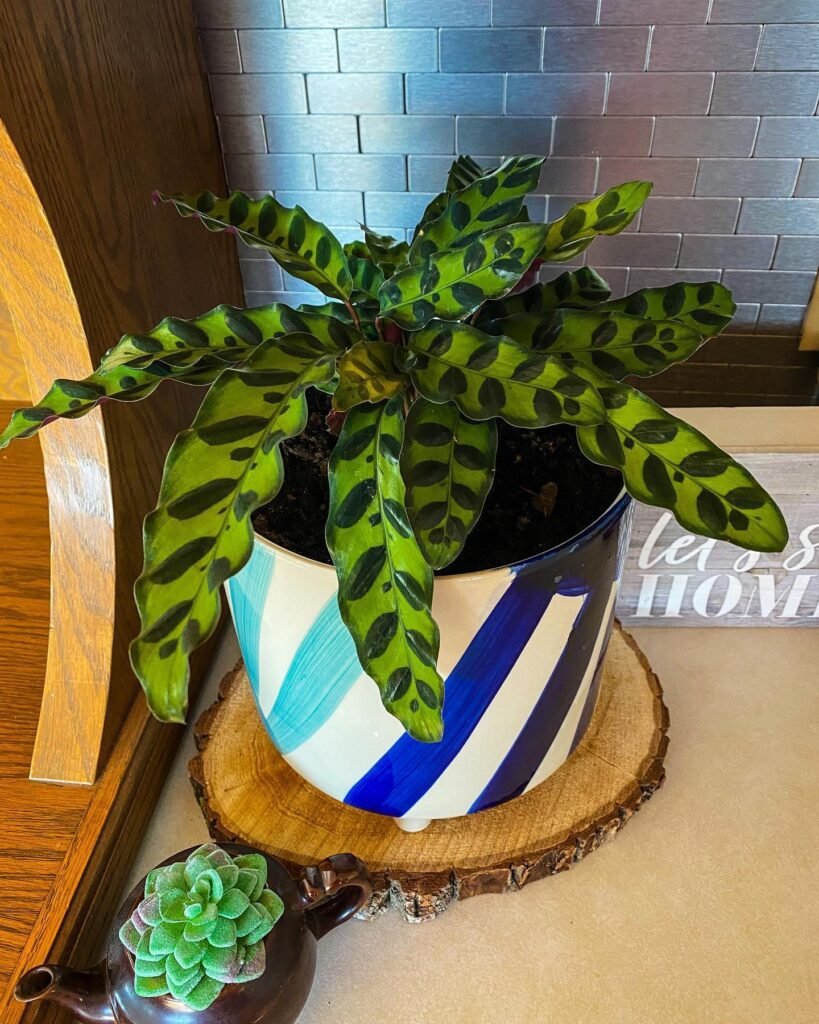

In order to promote healthy foliage development, Calathea Lancifolia, also known as the Rattlesnake Plant, benefits from regular fertilizing during the growing season. I recommend applying a weak dose of a nitrogen-rich foliage fertiliser once or twice a month. This will provide the essential nutrients needed to keep your plant thriving.
When it comes to the soil, Calathea Lancifolia prefers a well-draining and nutrient-rich environment. To create the ideal growing medium, I suggest using a mixture of peat-based potting mix and either perlite or sand. This will ensure that the soil retains enough moisture while allowing for adequate drainage, preventing the roots from becoming waterlogged.

Pruning and Maintenance for Rattlesnake Plant


Regular pruning and maintenance are essential for ensuring that your Rattlesnake Plant, also known as Calathea Lancifolia, looks its best. To keep your plant healthy and vibrant, it’s important to remove any yellowed or dying leaves. This not only maintains the overall appearance of the plant but also promotes its overall health.
Additionally, dust can accumulate on the leaves of the Rattlesnake Plant, affecting its ability to photosynthesize and thrive. To keep the leaves clean and free from debris, it is recommended to wipe them gently with a damp cloth. This will help the plant absorb light more effectively and maintain its beautiful appearance.
It’s important to note that using leaf shine products on the Rattlesnake Plant can actually do more harm than good. These products can damage the foliage and disrupt the natural processes of the plant. It’s best to avoid using such products and instead focus on natural methods of care and maintenance for your Rattlesnake Plant.

Propagating Calathea Lancifolia (Rattlesnake Plant)
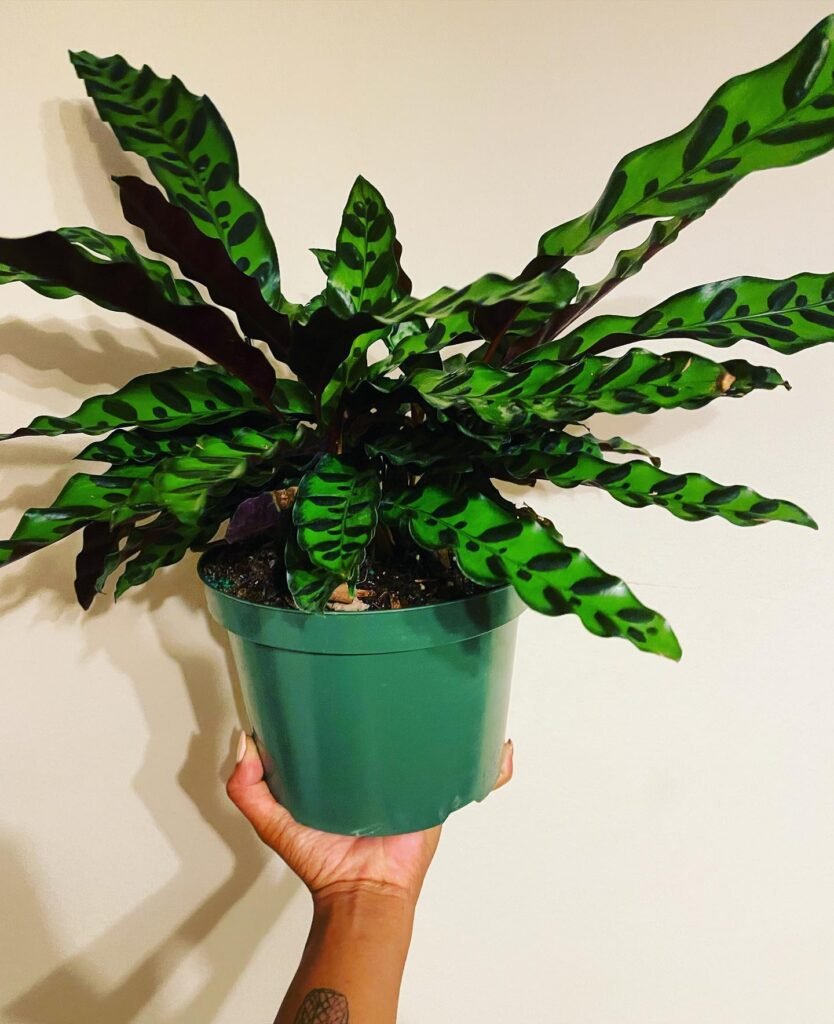

If you want to expand your collection of Calathea Lancifolia, there are two main methods of propagating this beautiful plant: division and stem cuttings.
Division
One way to propagate Calathea Lancifolia is through division. This involves separating the plant into smaller sections, each with its own roots and stems. To do this, carefully remove the plant from its pot and gently separate the roots into individual sections. Make sure each section has at least a few healthy leaves and roots. Then, plant each section in its own pot with well-draining soil, taking care to water and provide proper care for these new plants. Division is a reliable method that allows you to create multiple plants from a single parent plant.
Offshoots
Another method of propagating Calathea Lancifolia is by separating offshoots or new growth from the parent plant. Offshoots are small plants that develop from the base of the parent plant. When these offshoots are large enough, you can carefully separate them from the parent plant and pot them individually. Just like with division, ensure that each offshoot has enough roots and leaves to grow independently. Provide the offshoots with the same care and conditions as the parent plant to help them establish and thrive.
Stem Cuttings
Stem cuttings can also be taken to propagate Calathea Lancifolia. Choose a healthy stem with a few leaves and cut it just below a node. Remove any leaves from the bottom of the cutting, leaving only a few at the top. Place the cutting in a glass of water or well-draining soil, making sure to keep it moist. Over time, the cutting will develop roots and can be planted in its own pot. This method requires patience and attention to moisture levels, but it can be a rewarding way to generate new Calathea plants.
Whichever propagation method you choose, it is important to provide the new plants with proper care and conditions. Maintain consistent moisture levels, provide bright but indirect light, and keep the plants in a warm and humid environment to promote healthy growth. With time and care, you can successfully propagate Calathea Lancifolia and expand your collection of these striking Rattlesnake Plants.

Repotting Tips for Calathea Lancifolia
When your Calathea Lancifolia, known as the Rattlesnake Plant, outgrows its current pot, it’s time to repot. Here are some tips to ensure a smooth transition for your plant:
- Choose the right pot size: Select a pot that is slightly larger than the current one, allowing room for the roots to grow. This will provide the plant with space to thrive.
- Opt for well-draining soil: It is crucial to use well-draining soil to prevent waterlogged conditions. This helps avoid the risk of root rot and keeps your plant healthy. Consider using a mix of peat-based potting mix and perlite or sand.
- Loosen the roots: Before placing the plant in its new pot, gently loosen the roots to encourage healthy growth. This will also help the plant adapt to its new environment.
- Secure the plant in the soil: Once you’ve placed the Calathea Lancifolia in its new pot, make sure it is securely positioned in the soil. This will provide stability and support for the plant as it continues to grow.
After repotting, it’s essential to provide proper care and monitor the plant for any signs of stress or adjustment. With these repotting tips, your Calathea Lancifolia will have the space and conditions it needs to thrive in its new pot.
Toxicity of Calathea Lancifolia (Rattlesnake Plant)
The Rattlesnake Plant, Calathea Lancifolia, is deemed non-toxic to cats, making it a safe choice for homes with furry friends. However, it’s wise to keep an eye on your pets and little ones around any houseplants to prevent them from nibbling on the foliage.
Should you spot any odd behaviour or symptoms in your cat, dog, or child after they’ve been near the Rattlesnake Plant, it would be prudent to seek advice from a vet or doctor.
To avoid any mishaps, try to place the Rattlesnake Plant somewhere out of reach of both animals and children.
If you notice your pet taking an interest in the plant, think about offering them some pet-safe plants or toys instead to keep their curiosity at bay.
Keep a close watch on your pet’s health, particularly if they show signs of feeling unwell, like vomiting, diarrhoea, excessive drooling, or changes in their usual behaviour.
Should any of these symptoms arise, getting in touch with your vet promptly for a thorough check-up and advice is crucial.
Even though the Rattlesnake Plant is generally regarded as safe for cats, remember that every animal (and child) can have different reactions or sensitivities. It’s essential to stay observant and ensure the safety and happiness of your animal companions and little ones.
 The Calathea Lancifolia (Rattlesnake Plant) naturally purifies the air. It boosts humidity and removes toxins through transpiration, improving your home’s climate and your well-being. This makes the Rattlesnake Plant an attractive and beneficial air purifier.
The Calathea Lancifolia (Rattlesnake Plant) naturally purifies the air. It boosts humidity and removes toxins through transpiration, improving your home’s climate and your well-being. This makes the Rattlesnake Plant an attractive and beneficial air purifier.
Rattlesnake Plant Care Guide in the UK
Hello fellow plant enthusiasts! If you’ve got a Calathea Lancifolia, or Rattlesnake Plant, and want to ensure it thrives in the UK, you’re in the right place. As a tropical indoor plant, the Rattlesnake Plant requires specific care to keep it healthy and vibrant. Let me share some tips and tricks to help you become a pro at caring for your Calathea Lancifolia.
Lighting
Calathea Lancifolia loves indirect light or light shade. To provide the perfect lighting conditions, find a bright spot in a well-lit room, keeping the plant about 3 meters away from the window. Remember, direct sunlight can cause fading of the leaves, so it’s best to avoid it.
Watering
When it comes to watering, the rule of thumb for the Rattlesnake Plant is to keep the soil consistently moist. However, be careful not to overwater and let it sit in water or overly wet soil. Little and often is the way to go. Water your plant whenever the top inch of soil feels dry, and make sure to drain any excess water from the pot to prevent root rot.
Fertilizing
Regular fertilizing during the growing season will keep your Calathea Lancifolia happy and healthy. Choose a nitrogen-rich foliage fertiliser and apply it once or twice a month at a weak dosage. This will help promote lush foliage development and keep your Rattlesnake Plant thriving.
Humidity
Proper humidity levels are essential for the Calathea Lancifolia. This tropical beauty loves a bit of moisture in the air. To increase humidity, mist the leaves regularly or place the plant in a naturally humid location like a bathroom or kitchen. This will prevent the edges of the leaves from drying out and keep them looking their best.
Maintenance
Maintaining your Rattlesnake Plant involves some regular TLC. Pruning is important to remove any yellowed or dying leaves and keep the plant looking neat. Additionally, dust can accumulate on the leaves, so give them a gentle wipe with a damp cloth to keep them clean and healthy. Avoid using leaf shine products, as they can harm the foliage.
Now that you have a comprehensive care guide for your Calathea Lancifolia, I hope you feel confident in providing the best care for your Rattlesnake Plant. Remember, a happy and healthy plant will reward you with its lush beauty throughout the year. Enjoy your tropical indoor companion and happy gardening!
Helpful Videos about Calathea Lancifolia (Rattlesnake Plant)
Check out these fantastic videos I’ve discovered on caring for the Calathea Lancifolia (Rattlesnake Plant). They’re packed with advice to simplify looking after your plant. Ideal for anyone new to gardening!
- Rattlesnake Calathea (Calathea lancifolia) Plant Care Guide For Beginners
- CALATHEA RATTLESNAKE CARE GUIDE FOR BEGINNERS | water, light, humidity, propagation, and more!
FAQ about Caring for Calathea Lancifolia (Rattlesnake Plant)

Curious about caring for your Calathea Lancifolia (Rattlesnake Plant)? You’ve found the perfect place! I’ve compiled all the top questions to make nurturing your Rattlesnake Plant straightforward. From figuring out the right watering schedule to addressing any leaf problems, I’m here to help.
Calathea Lancifolia, also known as the Rattlesnake Plant, is a tropical houseplant known for its striking, patterned leaves that resemble a rattlesnake’s skin.
Water when the top inch of soil feels dry, typically once a week, but adjust based on your home’s humidity and temperature.
Choose a spot with bright, indirect sunlight. Avoid direct sun, which can fade the leaves’ patterns.
Yes, it thrives in high humidity. Aim for 60% or higher. Use a humidifier or place the plant on a pebble tray with water to increase humidity.
Repot in the spring, selecting a pot 2-3 cm larger in diameter than the current one. Use a well-draining, peat-based potting mix.
Yes, but ensure it’s in a shaded spot. UK summers can be variable, so monitor the plant for any stress signs.
Keep it in temperatures between 18°C and 24°C. Avoid draughts and sudden temperature changes.
Besides a humidifier, misting the leaves regularly can help, but ensure the leaves don’t stay wet for too long to avoid fungal diseases.
Yellow leaves can indicate overwatering or poor drainage. Ensure the pot has good drainage and the soil isn’t constantly soggy.
Use a half-strength liquid houseplant fertilizer once a month during the growing season (spring and summer).
Brown edges can be a sign of low humidity or watering with tap water high in fluoride. Use filtered water and increase humidity around the plant.
It’s best propagated by division during repotting. Gently separate the roots and pot each section in its own container.
Inspect regularly for pests like spider mites. Wipe leaves with a damp cloth and use an insecticidal soap or neem oil if pests are found.
Yes, it’s non-toxic and safe around pets.
It can grow up to 30 inches tall and wide, depending on its care and environment.
Gently wipe them with a soft, damp cloth to remove dust and help the plant photosynthesize efficiently.
Check if it’s pot-bound and needs repotting, ensure it’s getting enough light (but not direct sunlight), and adjust watering and humidity levels as needed.
Yes, bathrooms usually have higher humidity, which can be beneficial for the plant, provided there is enough indirect light.
No, it’s a tropical plant and cannot withstand cold temperatures. Keep it indoors, especially through the cooler months.
I hope this FAQ has helped you understand how to care for your Calathea Lancifolia (Rattlesnake Plant) a bit better. If I’ve missed something, don’t worry! Just ask in the comments, and I’ll do my best to answer. Remember, we all start from scratch with plants, and there’s always something new to learn as we grow with them.
Conclusion
Caring for Calathea Lancifolia, or the Rattlesnake Plant, in the UK requires attention to specific needs such as light, watering, fertilizing, and humidity. By following the tips and recommendations outlined in this guide, you can ensure that your Calathea Lancifolia thrives as a lush, tropical houseplant.
Remember to provide indirect light to your Calathea Lancifolia, as direct sunlight can cause the leaves to fade. Keep the soil consistently moist, but be cautious not to overwater and cause root rot. Maintaining proper humidity levels is essential for this plant, so misting the leaves or placing it in a humid location like the bathroom or kitchen can be beneficial.
Regular maintenance is also important for the overall care of your Rattlesnake Plant. Prune any yellowed or dying leaves and wipe the leaves with a damp cloth to keep them clean and debris-free. With proper care, your Calathea Lancifolia will be a stunning addition to your indoor plant collection in the UK.

